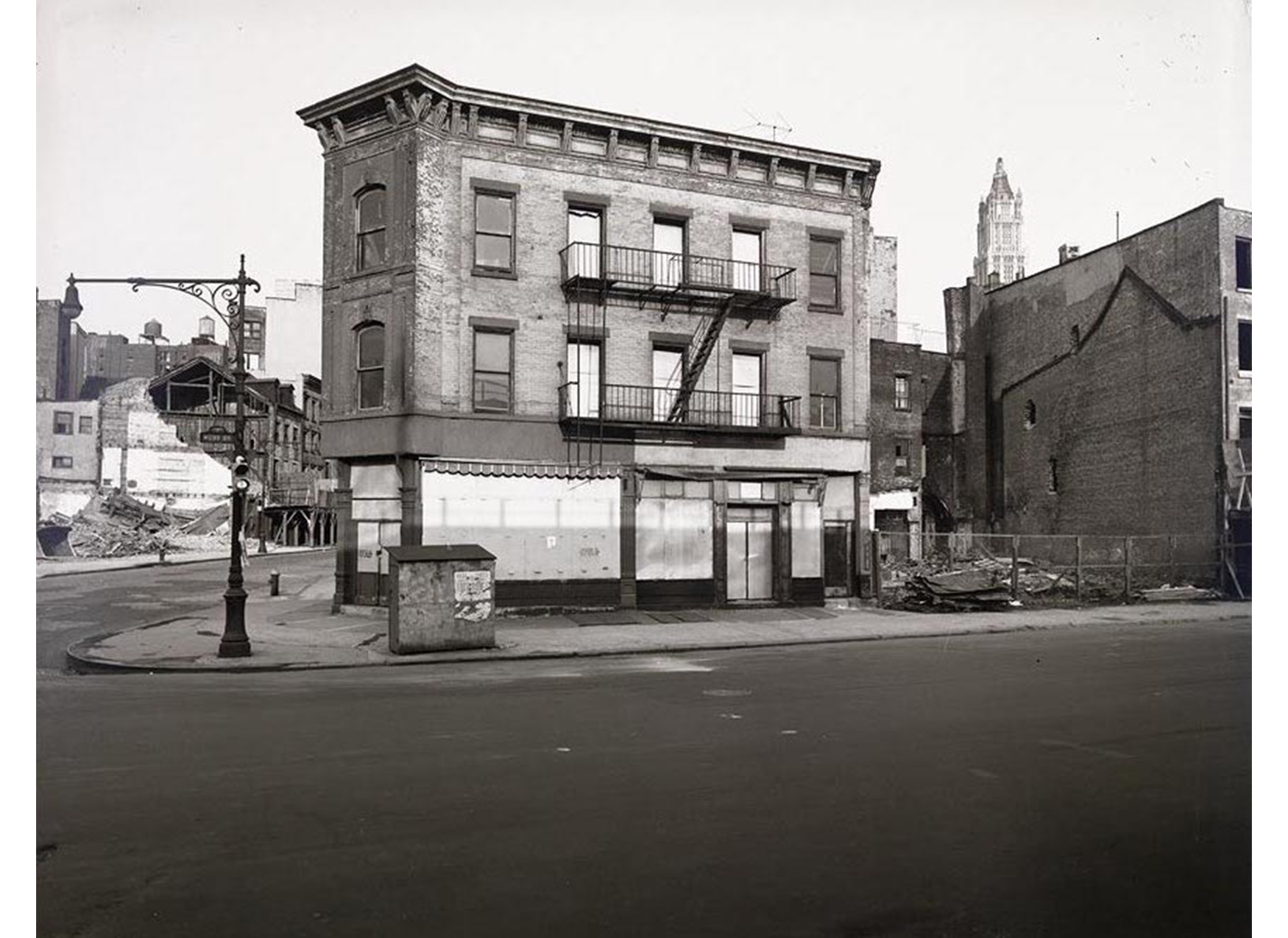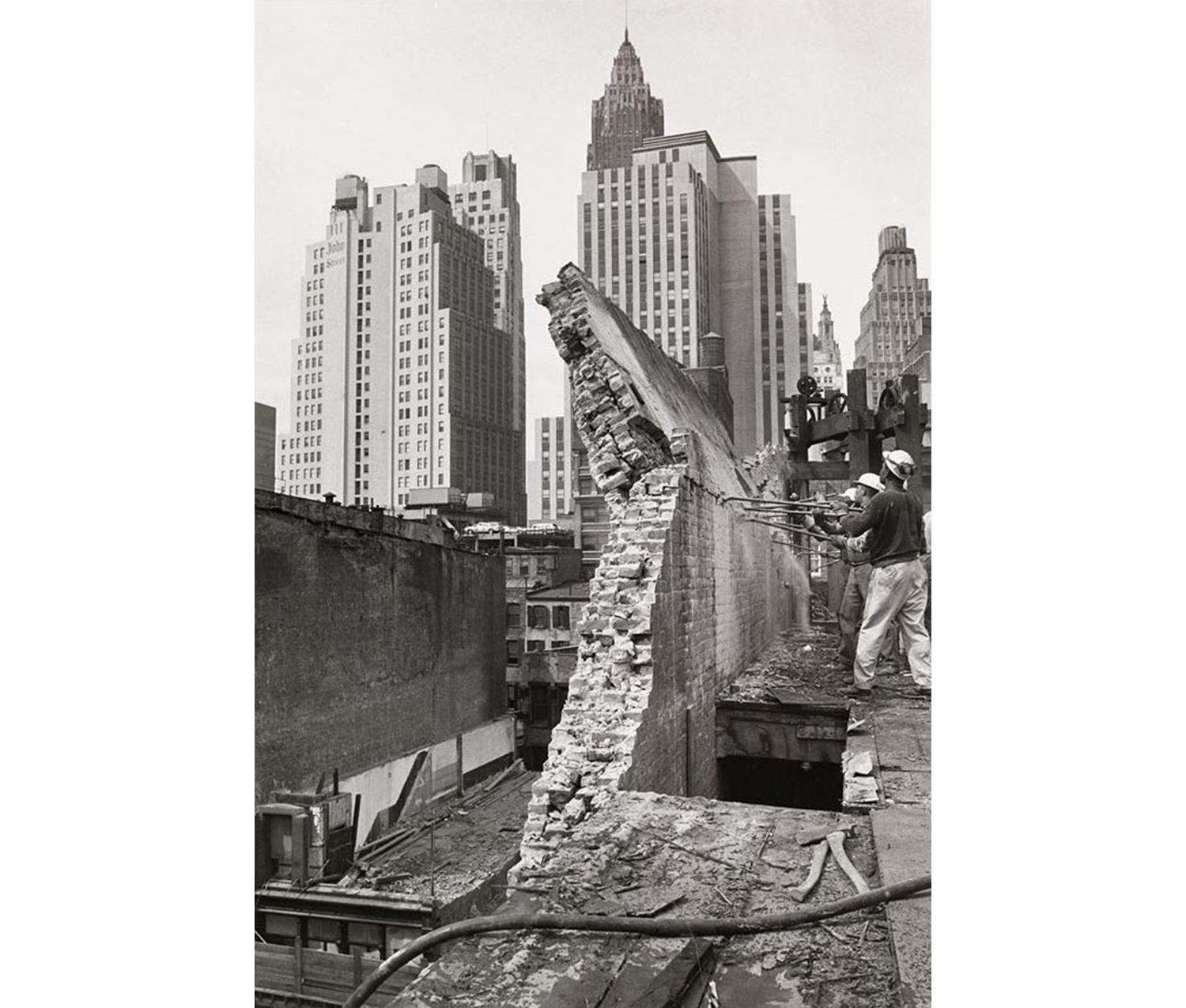
The Destruction of Lower Manhattan
Guest blogger Julie Warchol was a participant in the 2011 Summer Institute in Art Museum Studies and is currently a curatorial volunteer in the Cunningham Center for Prints, Drawings, and Photographs.
In 1966–1967, several decades before the World Trade Center attacks, sixty acres of Lower Manhattan were systematically demolished and few, except Danny Lyon, seemed to notice or care. A Brooklyn native and young documentary photographer, Lyon had just returned to New York City after spending two years photographing and riding with outlaw motorcyclists for a series called The Bikeriders. He settled into a loft apartment at the corner of Beekman and Williams Streets, on the outskirts of a neighborhood that was to be destroyed. This portion of Manhattan contained some of New York’s oldest streets which were constructed in the 19th-century. In their prime, they had been bustling centers of mercantile activity, but were in an apparent state of decline by the 1960s. Many of these Lower Manhattan buildings, which were deemed architecturally insignificant, were razed in order to construct Battery Park City and the World Trade Center as well as other new buildings which have come to characterize the city. In the midst of this rapid leveling, Danny Lyon took to the streets with his large format camera to document the buildings in their final days, the looters and few remaining occupants, and the eventual demolition itself.
The views of New York City presented in these photographs are jarring; the desolate brick buildings and cobble-stone streets seldom contain people, cars, or any other signs of life. Simultaneously dilapidated and majestic, they stand as symbols of a past century that were sacrificed for the creation of more modern structures – a classic American strategy of development. Recognizing the symbolic importance of these neighborhoods and their fate, Lyon takes a subjective, and therefore novel, approach to his documentary photographs. Publishing journal excerpts alongside the photographs in his book The Destruction of Lower Manhattan, Lyon maps the progression of his work and encourages the viewer’s sympathy. By the end of the project, Lyon had shifted his focus from the ill-fated buildings to the demolition workers themselves, those unsung heroes who take great pride in their work. In these photographs, Lyon finds somber beauty not only in the architectural remnants of 19th-century New York, but also in their destruction.
“I came to see the buildings as fossils of a time past. These buildings were used during the Civil War. The men were all dead, but the buildings were still here, left behind as the city grew around them. Skyscrapers emerged from the rock of Manhattan like mountains growing out from the earth. And here and there near their base, caught between them on their old narrow streets, were the houses of the dead, the new buildings of their own time awaiting demolition. In their last days and months they were kept company by bums and pigeons.
For a hundred years they have stood in the darkness and the day. In the morning the sun has shined on their one side, and in the evening on another. Now, in the end, they are visited by demolition men. Slavs, Italians, Negroes from the South, American workers of 1967 drinking pop-top soda on their beams at lunch time, risking their lives for $5.50 an hour, pulling apart brick by brick and beam by beam, the work of other American workers who once stood on the same walls and held the same bricks, then new, so long ago.” – Danny Lyon, The Destruction of Lower Manhattan

Danny Lyon. American, born 1942. Washington Street. View north from Chambers Street from The Destruction of Lower Manhattan, 1967 negative; 2007 print. Gelatin silver print. Gift of Nicole Moretti Ungar, class of 1982, and Jon Ungar. Photography by Petegorsky/Gipe. SC 2011.71.21.

Danny Lyon. American, born 1942. Eddie Grant and Cleveland Sims...from The Destruction of Lower Manhattan, 1967 negative; 2007 print. Gelatin silver print. Gift of Nicole Moretti Ungar, class of 1982, and Jon Ungar. Photography by Petegorsky/Gipe. SC 2011.71.28.

Danny Lyon. American, born 1942. 185 West Street at Chambers from The Destruction of Lower Manhattan, 1967 negative; 2007 print. Gelatin silver print. Gift of Nicole Moretti Ungar, class of 1982, and Jon Ungar. Photography by Petegorsky/Gipe. SC 2011.71.26.

Danny Lyon. American, born 1942. Dropping a wall from The Destruction of Lower Manhattan, 1967 negative; 2007 print. Gelatin silver print. Gift of Nicole Moretti Ungar, class of 1982, and Jon Ungar. Photography by Petegorsky/Gipe. SC 2011.71.33.

Danny Lyon. American, born 1942. Housewrecker from The Destruction of Lower Manhattan, 1967 negative; 2007 print. Gelatin silver print. Gift of Nicole Moretti Ungar, class of 1982, and Jon Ungar. Photography by Petegorsky/Gipe. SC 2011.71.35.